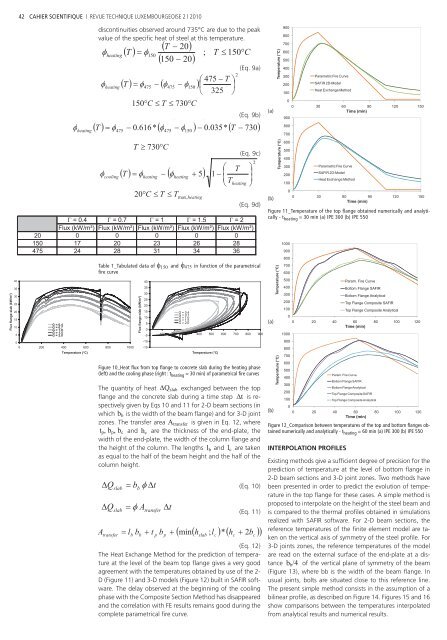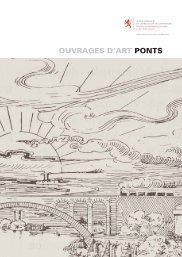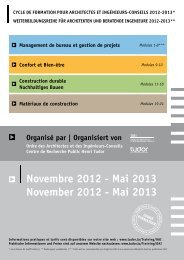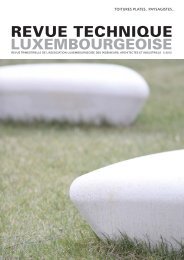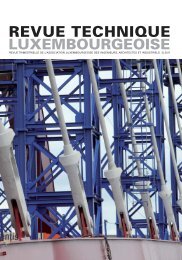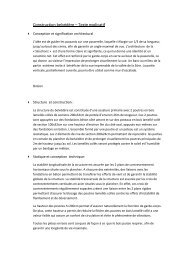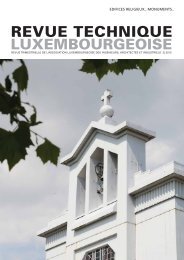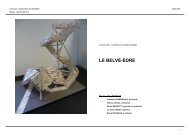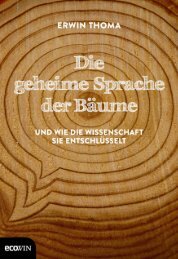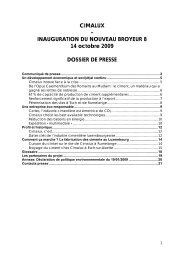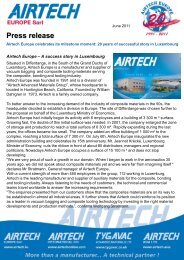cahier scientifique revue technique luxembourgeoise
cahier scientifique revue technique luxembourgeoise
cahier scientifique revue technique luxembourgeoise
Erfolgreiche ePaper selbst erstellen
Machen Sie aus Ihren PDF Publikationen ein blätterbares Flipbook mit unserer einzigartigen Google optimierten e-Paper Software.
Flux flange-slab (kW/m²)<br />
40<br />
35<br />
30<br />
25<br />
20<br />
15<br />
10<br />
5<br />
42 CAHIER SCIENTIFIQUE | REVUE TECHNIQUE LUXEMBOURGEOISE 2 | 2010<br />
�<br />
�<br />
heating<br />
discontinuities observed around 735°C are due to the peak<br />
value of the specifi c heat of steel at this temperature.<br />
�<br />
�<br />
heating<br />
heating<br />
�T� �T � 20�<br />
�150 � 20�<br />
� �<br />
; T � 150�C<br />
(Eq. 9a)<br />
(Eq. 9b)<br />
(Eq. 9c)<br />
(Eq. 9d)<br />
� = 0.4 � = 0.7 � = 1 � = 1.5 � � � = 2<br />
Flux (kW/m²) Flux (kW/m²) Flux (kW/m²) Flux (kW/m²) Flux (kW/m²)<br />
20<br />
150<br />
�0 17<br />
� 0<br />
20<br />
0<br />
23 �<br />
0<br />
�26<br />
0<br />
28<br />
475 24 28 31 34 � �36<br />
� �<br />
G = 0.4<br />
G = 0.7<br />
G = 1.0<br />
G = 1.5<br />
G = 2.0<br />
� �<br />
150<br />
475 475 150<br />
� 475 � T �<br />
� �<br />
� 325 �<br />
150 �C � T � 730�C<br />
�T��� � �� � � �<br />
� �<br />
� � � . 616*<br />
� � � � 0.<br />
035*<br />
T � 730<br />
�T� � � � �<br />
�<br />
cooling<br />
475<br />
0<br />
0 200 400 600 800 1000<br />
Temperature (°C)<br />
0 475 150<br />
T � 730 �C<br />
�T��� � ���5� heating<br />
20� �<br />
heating<br />
C � T Tmax,<br />
heating<br />
� �<br />
Table � 1_Tabulated � � data of �150 and �475 in �<br />
�<br />
function of � the parametrical<br />
fire curve<br />
Flux flange-slab (kW/m²)<br />
�� ��<br />
�� ��<br />
Figure 10_Heat fl ux from top fl ange to concrete slab during the heating phase<br />
(left) and the cooling phase (right : t heating = 30 min) of parametrical fi re curves<br />
The quantity of heat �Qslab exchanged between the top<br />
fl ange and the concrete slab during a time step �t is respectively<br />
given by Eqs 10 and 11 for 2-D beam sections (in<br />
which bb is the width of the beam fl ange) and for 3-D joint<br />
zones. The transfer area Atransfer is given in Eq. 12, where<br />
tp, bp, bc and hc are the thickness of the end-plate, the<br />
width of the end-plate, the width of the column fl ange and<br />
the height of the column. The lengths lb and lc are taken<br />
as equal to the half of the beam height and the half of the<br />
column height.<br />
� � b � �t<br />
Qslab b<br />
�Qslab � � Atransfer<br />
�t<br />
transfer<br />
b<br />
b<br />
(Eq. 10)<br />
(Eq. 11)<br />
(Eq. 12)<br />
The Heat Exchange Method for the prediction of temperature<br />
at the level of the beam top fl ange gives a very good<br />
agreement with the temperatures obtained by use of the 2-<br />
D (Figure 11) and 3-D models (Figure 12) built in SAFIR software.<br />
The delay observed at the beginning of the cooling<br />
phase with the Composite Section Method has disappeared<br />
and the correlation with FE results remains good during the<br />
complete parametrical fi re curve.<br />
2<br />
� T<br />
1 � �<br />
�<br />
� T<br />
heating<br />
�<br />
�<br />
�<br />
�<br />
40<br />
35<br />
30<br />
25<br />
20<br />
� �<br />
15<br />
10<br />
5<br />
0<br />
G = 0.4<br />
G = 0.7<br />
G = 1.0<br />
G = 1.5<br />
G = 2.0<br />
-5<br />
0<br />
-10<br />
-15<br />
100 200 300 400 500 600 700 800 900<br />
p<br />
p<br />
Temperature (°C)<br />
�min�h; l �* �h�b�� A � l b � t b �<br />
2<br />
slab<br />
c<br />
c<br />
2<br />
c<br />
(a)<br />
(b)<br />
Time (min)<br />
Figure 11_Temperature of the top flange obtained numerically and analytically<br />
- theating = 30 min (a) IPE 300 (b) IPE 550<br />
� �<br />
(a)<br />
Temperature (°C)<br />
Temperature (°C)<br />
Temperature (°C)<br />
Temperature (°C)<br />
900<br />
800<br />
700<br />
600<br />
500<br />
400<br />
300<br />
200<br />
100<br />
Parametric Fire Curve<br />
SAFIR 2D-Model<br />
Heat Exchange Method<br />
0<br />
0 30 60 90 120 150<br />
Time (min)<br />
900<br />
800<br />
700<br />
600<br />
500<br />
400<br />
300<br />
200<br />
100<br />
1000<br />
Parametric Fire Curve<br />
SAFIR 2D-Model<br />
Heat Exchange Method<br />
0<br />
0 30 60 90 120 150<br />
900<br />
800<br />
700<br />
600<br />
500<br />
400<br />
300<br />
200<br />
100<br />
1000<br />
� �<br />
0<br />
0 20 40 60<br />
Time (min)<br />
80 100 120<br />
900<br />
800<br />
700<br />
600<br />
500<br />
400<br />
300<br />
200<br />
100<br />
0<br />
Param. Fire Curve<br />
(b)<br />
0 20 40 60<br />
Time (min)<br />
80 100 120<br />
Figure 12_Comparison between temperatures of the top and bottom fl anges obtained<br />
numerically and analytically - theating = 60 min (a) IPE 300 (b) IPE 550<br />
INTERPOLATION PROFILES<br />
Param. Fire Curve<br />
Bottom Flange SAFIR<br />
Bottom Flange Analytical<br />
Top Flange Composite SAFIR<br />
Top Flange Composite Analytical<br />
Bottom Flange SAFIR<br />
Bottom Flange Analytical<br />
Top Flange Composite SAFIR<br />
Top Flange Composite Analytical<br />
Existing methods give a suffi cient degree of precision for the<br />
prediction of temperature at the level of bottom fl ange in<br />
2-D beam sections and 3-D joint zones. Two methods have<br />
been presented in order to predict the evolution of temperature<br />
in the top fl ange for these cases. A simple method is<br />
proposed to interpolate on the height of the steel beam and<br />
is compared to the thermal profi les obtained in simulations<br />
realized with SAFIR software. For 2-D beam sections, the<br />
reference temperatures of the fi nite element model are taken<br />
on the vertical axis of symmetry of the steel profi le. For<br />
3-D joints zones, the reference temperatures of the model<br />
are read on the external surface of the end-plate at a distance<br />
bb/4 of the vertical plane of symmetry of the beam<br />
(Figure 13), where bb is the width of the beam fl ange. In<br />
usual joints, bolts are situated close to this reference line.<br />
The present simple method consists in the assumption of a<br />
bilinear profi le, as described on Figure 14. Figures 15 and 16<br />
show comparisons between the temperatures interpolated<br />
from analytical results and numerical results.


